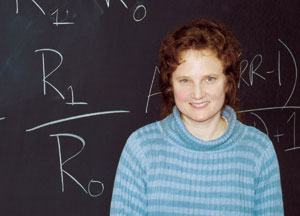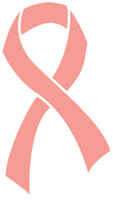

A publication of The Graduate School, University of North Carolina at Chapel Hill
On-line Version Spring 2003
Home | Back issues | About us | The Graduate School | UNC-Chapel Hill | Make a gift

 |
| Photo by Alexandra Obregon |
| Beverly Rockhill hopes physicians and patients take the time to talk about what risk numbers mean for developing breast cancer. |
Beverly Rockhill Untangles the Facts on Breast Cancer
Beverly Rockhill, UNC alumna and assistant professor in the Department of Epidemiology, had entered a master’s program in demography at the University of Pennsylvania when her mother developed breast cancer. Rockhill spent hours in the medical library reading about the disease, ultimately garnering an interest in epidemiology. After working for a few years, Rockhill elected to enter Carolina’s doctoral program in epidemiology, also earning a place in what is now the Royster Society of Fellows.
Rockhill continued epidemiological research in breast cancer as a postdoctoral fellow and junior faculty member at Brigham and Women’s Hospital and Harvard Medical School, but fond memories drew her back to Chapel Hill. Rockhill talks with The Fountain’s Brandee Hayhurst about risk factors for breast cancer and how women can get accurate information about the disease.
The Fountain: What are the most important risk factors for breast cancer?
Beverly Rockhill (BR): There’s a hypothesis that breast cancer in women is related to lifetime exposure to circulating ovarian hormones. Most of the things scientists call risk factors are ultimately related to the effects of repeated exposure of the breasts to estrogen. Things that happen in a woman’s life that reduce the effects of estrogen on the breast will lower her chances of getting breast cancer, according to this hypothesis.
These factors include having more children earlier in life, starting menstruation later in life, going through menopause early, or, more drastically, removal of ovaries for medical reasons. A factor that increases a woman’s risk of breast cancer is taking post-menopausal hormones, which mimic the hormones from the ovaries. High levels of physical activity can reduce risk for breast cancer, because women who exercise often can affect their ovarian function. Too much exercise, however, can lead to estrogen levels that are too low. If a woman ceases menstruating because of too much exercise, she is at increased risk of osteoporosis. Women need to take into account many aspects of their health, and not focus only on breast cancer, when they think about the role of estrogen.
Fountain: What are some problems in finding good information about risk factors for breast cancer?
BR: I think there's a lot of misinformation out there. In a climate of misinformation, it is the rare individual that has the capacity to know who to go to and what questions to ask. Sometimes advertisements are designed to alarm women, to get women to pay for a genetic test or for preventive medicine by telling them they are at high risk. It is important for women to realize that while scientists know some things about what causes breast cancer, the disease is very complex. Scientists know very little when it comes to predicting which specific women are going to get breast cancer.
Fountain: What are some examples of misinformation out there?
BR: One example is the famous one in eight number, that one in eight women will develop breast cancer. A lot of people don't know how to interpret that number. It does not mean that in a group of eight women, one of them will get breast cancer in the next year, or even the next 10 years. In a group of eight babies, scientists have estimated that over the next 85 years one of them will develop breast cancer. It's an abstract statistic, whereas much more useful information is an individual woman's risk for breast cancer over the next five or 10 years. Those numbers tend to be quite low for most women, fortunately.
Also, there are a lot of urban
legends. For instance, using antiperspirant clogs the pores under your
arms and causes breast cancer. There aren't scientific data behind this
idea at all. Women need to be alert about the source of information on
risk factors. If it comes from the New England Journal of Medicine
there's some weight behind it. If you just hear it or read it on a random
place on the Internet, you need to question whether it is supported by
scientific evidence.
Fountain: How do healthcare providers communicate about risk factors for breast cancer, and why do patients often not comply with physicians' advice on changing lifestyle?
BR: That's a hard question. I think it's a myth in the field of health education that once a person has information about how to improve their health, they will act on it. All of us have examples in our daily lives where we don't. What goes into determining behavior is very complex. You could tell a woman that she can lower her risk of cancer with one hour of physical activity every day. But what if she's got such a stressful job that she just can't fit that in? Here, we get at the issue of personal freedom, and the reality that avoiding disease is not the number one priority of everyone at every time. Nor should it be.
It's also hard to change. People have an innate sense of how much something is really going to affect their risk, even though the doctor may not be communicating this fully. A physician could tell a woman she's at high risk for breast cancer and can cut the risk in half by changing her behavior. But if cutting risk in half means a 99/100 chance of not getting cancer versus a 98/100 chance, she may just keep doing what she's doing.
Fountain: What advice would you give to physicians and patients when it comes to talking about the risk for developing cancer?
BR: My wish would be that both
physicians and patients take time to educate themselves. People need to
be educated when it comes to their healthcare, because doctor visits are
getting shorter and there's less time for interaction. It would be great
if everyone could have a basic understanding of probability, since so
much of what is communicated about health today is in terms of risk and
probability. Without this foundation it's easy to take statements about
diseases and get really scared. And probability is something many people
are not familiar with, even though it comes up in so many areas of our
lives. Ask physicians to explain where numbers come from and what they
mean. That's the role of the
physician and the scientist to the public.
The best doctors can do when talking about risk is to point out the uncertainties in the numbers. Today a study may find that oral contraceptive use increases risk for breast cancer, next week a study might say it doesn't. Because of the uncertainty, you have to bring a lot more than scientific evidence into individual patient decisions, including their subjective feelings, individual preferences and values. The risk numbers only go so far.
|
© 2002, The Graduate School, The University of
North Carolina at Chapel Hill
All text and images are property of The Graduate School
at the University of North Carolina-Chapel Hill. Contact Sandra Hoeflich
at shoeflic@email.unc.edu
to request permission for reproduction.
